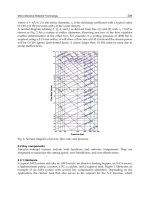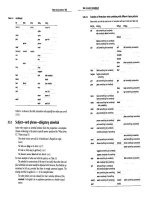Chapter 109. Disorders of Platelets and Vessel Wall (Part 1) docx
Bạn đang xem bản rút gọn của tài liệu. Xem và tải ngay bản đầy đủ của tài liệu tại đây (43.45 KB, 5 trang )
Chapter 109. Disorders of Platelets
and Vessel Wall
(Part 1)
Harrison's Internal Medicine > Chapter 109. Disorders of Platelets and
Vessel Wall
Disorders of Platelets and Vessel Wall: Introduction
Hemostasis is a dynamic process in which the platelet and the blood vessel
wall play key roles. Platelets become activated upon adhesion to von Willebrand
factor (vWF) and collagen in the exposed subendothelium after injury. Platelet
activation is also mediated through shear forces imposed by blood flow itself,
particularly in areas where the vessel wall is diseased, and is also affected by the
inflammatory state of the endothelium.
The activated platelet surface provides the major physiologic site for
coagulation factor activation, which results in further platelet activation and fibrin
formation. Genetic and acquired influences on the platelet and vessel wall, as well
as on the coagulation and fibrinolytic systems, determine whether normal
hemostasis, or bleeding or clotting symptoms, will result.
The Platelet
Platelets are released from the megakaryocyte, likely under the influence of
flow in the capillary sinuses. The normal blood platelet count is 150,000–
450,000/µL.
The major regulator of platelet production is the hormone thrombopoietin
(TPO), which is synthesized in the liver. Synthesis is increased with inflammation
and specifically by interleukin 6. TPO binds to its receptor on platelets and
megakaryocytes, by which it is removed from the circulation.
Thus, a reduction in platelet and megakaryocyte mass increases the level of
TPO, which then stimulates platelet production. Platelets circulate with an average
life span of 7–10 days.
Approximately one-third of the platelets reside in the spleen, and this
number increases in proportion to splenic size, although the platelet count rarely
decreases to <40,000/µL as the spleen enlarges. Platelets are physiologically very
active but are anucleate, and thus they have limited capacity to synthesize new
proteins.
Normal vascular endothelium contributes to preventing thrombosis by
inhibiting platelet function (Chap. 59). When vascular endothelium is injured,
these inhibitory effects are overcome, and platelets adhere to the exposed intimal
surface primarily through vWF, a large multimeric protein present in both plasma
and in the extracellular matrix of the subendothelial vessel wall.
Platelet adhesion results in the generation of intracellular signals that lead
to activation of the platelet glycoprotein (Gp) IIb/IIIa (α
IIb
β
3
) receptor and
resultant platelet aggregation.
Activated platelets undergo release of their granule contents, including
nucleotides, adhesive proteins, growth factors, and procoagulants that serve to
promote platelet aggregation and blood clot formation, and influence the
environment of the forming clot.
During platelet aggregation, additional platelets are recruited to the site of
injury, leading to the formation of an occlusive platelet thrombus. The platelet
plug is stabilized by the fibrin mesh that develops simultaneously as the product of
the coagulation cascade.
The Vessel Wall
Endothelial cells line the surface of the entire circulatory tree, totaling 1–6
x 10
13
cells, enough to cover a surface area equivalent to about six tennis courts.
The endothelium is physiologically active, controlling vascular permeability, flow
of biologically active molecules and nutrients, blood cell interactions with the
vessel wall, the inflammatory response, and angiogenesis.
The endothelium normally presents an antithrombotic surface (Chap. 59)
but rapidly becomes prothrombotic when stimulated, which promotes coagulation,
inhibits fibrinolysis, and activates platelets.
In many cases, endothelium-derived vasodilators are also platelet inhibitors
(e.g., nitric oxide) and, conversely, endothelium-derived vasoconstrictors (e.g.,
endothelin) can also be platelet activators.
The net effect of vasodilation and inhibition of platelet function is to
promote blood fluidity, whereas the net effect of vasoconstriction and platelet
activation is to promote hemostasis.
Thus, blood fluidity and hemostasis are regulated by the balance of
antithrombotic/prothrombotic and vasodilatory/vasoconstrictor properties of
endothelial cells.









